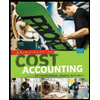
Concept explainers
Accounting for materials costs
In papermaking operations for companies such as International Paper Company, wet pulp is fed into paper machines, which press and dry pulp into a continuous sheet of paper. The paper is formed at very high speeds (60 mph). Once the paper is formed, the paper is rolled onto a reel at the back end of the paper machine. One of the characteristics of papermaking is the creation of “broke” paper. Broke is paper that fails to satisfy quality standards and is therefore rejected for final shipment to customers. Broke is recycled back to the beginning of the process by combining the recycled paper with virgin (new) pulp material. The combination of virgin pulp and recycled broke is sent to the paper machine for papermaking. Broke is fed into this recycle process continuously from all over the facility.
In this industry, it is typical to charge the papermaking operation with the cost of direct materials, which is a mixture of virgin materials and broke. Broke has a much lower cost than does virgin pulp. Therefore, the more broke in the mixture, the lower the average cost of direct materials to the department. Papermaking managers frequently comment on the importance of broke for keeping their direct materials costs down.
- a. How do you react to this accounting procedure?
- b. What “hidden costs” are not considered when accounting for broke as described?
Want to see the full answer?
Check out a sample textbook solution
Chapter 3 Solutions
Bundle: Managerial Accounting, 15th + Cengagenowv2, 1 Term Printed Access Card
- Can you explain the correct methodology to solve this financial accounting problem?arrow_forwardCan you solve this general accounting question with the appropriate accounting analysis techniques?arrow_forwardCan you help me find the accurate solution to this financial accounting problem using valid principles?arrow_forward
- Please help me solve this financial accounting question using the right financial principles.arrow_forwardI am searching for the accurate solution to this general accounting problem with the right approach.arrow_forwardEquipment with a cost of $2,340,000 has an estimated salvage value of $73,000 and an estimated life of 5 years or 62,000 hours. It is to be depreciated using the units-of-activity method. What is the amount of depreciation for the first full year, during which the equipment was used for 11,500 hours?arrow_forward
- Felicity Systems has net income of $275,000, net sales of $1,950,000, and average total assets of $1,250,000. What is its return on total assets?arrow_forwardWhat is its return on total assets?arrow_forwardPlease provide the correct answer to this general accounting problem using valid calculations.arrow_forward
 Managerial AccountingAccountingISBN:9781337912020Author:Carl Warren, Ph.d. Cma William B. TaylerPublisher:South-Western College Pub
Managerial AccountingAccountingISBN:9781337912020Author:Carl Warren, Ph.d. Cma William B. TaylerPublisher:South-Western College Pub Financial And Managerial AccountingAccountingISBN:9781337902663Author:WARREN, Carl S.Publisher:Cengage Learning,
Financial And Managerial AccountingAccountingISBN:9781337902663Author:WARREN, Carl S.Publisher:Cengage Learning, Principles of Cost AccountingAccountingISBN:9781305087408Author:Edward J. Vanderbeck, Maria R. MitchellPublisher:Cengage Learning
Principles of Cost AccountingAccountingISBN:9781305087408Author:Edward J. Vanderbeck, Maria R. MitchellPublisher:Cengage Learning Cornerstones of Cost Management (Cornerstones Ser...AccountingISBN:9781305970663Author:Don R. Hansen, Maryanne M. MowenPublisher:Cengage LearningPrinciples of Accounting Volume 2AccountingISBN:9781947172609Author:OpenStaxPublisher:OpenStax College
Cornerstones of Cost Management (Cornerstones Ser...AccountingISBN:9781305970663Author:Don R. Hansen, Maryanne M. MowenPublisher:Cengage LearningPrinciples of Accounting Volume 2AccountingISBN:9781947172609Author:OpenStaxPublisher:OpenStax College




